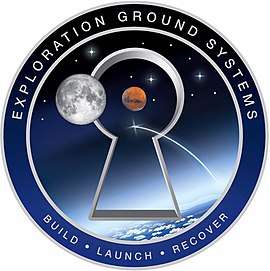Exploration Ground Systems
The Exploration Ground Systems (EGS) Program (formerly the Ground Systems Development and Operations Program[1]) is one of three NASA programs based at NASA's Kennedy Space Center in Florida. EGS was established to develop and operate the systems and facilities necessary to process and launch rockets and spacecraft during assembly, transport and launch.[2] Unlike previous work focusing on a single kind of launch vehicle, such as the Saturn V or space shuttle, EGS is preparing the infrastructure to support several different kinds of spacecraft and rockets that are in development, including NASA's Space Launch System (SLS) rocket and Orion spacecraft for Artemis 1.[3] [4] Artemis 1 is the first in a series of increasingly complex missions that will enable human exploration to the Moon and Mars.[5][6][7]
 | |
| Country | United States of America |
|---|---|
| Organization | NASA |
| Status | Ongoing |
EGS assets
Launch director
Charlie Blackwell-Thompson serves as launch director for NASA's Exploration Ground Systems Program. She will oversee the countdown and liftoff of NASA's Space Launch System rocket and Orion spacecraft. Named to the position in January 2016, Blackwell-Thompson is NASA's first female launch director.[8][9]
Milestones
August 31, 2018 – The Mobile Launcher Platform (MLP) arrives at Launch Pad 39B. The ML underwent a fit check, followed by several days of systems testing.[10]
September 8, 2018 – The MLP, atop Crawler-transporter 2, moves into the VAB for the first time.[11][12]
October 17, 2018 – The first high speed retract test was completed on the Orion Service Module Umbilical (OSMU) on the MLP. The test verified umbilical arm alignment, rotation speed, and latch back systems. The OSMU will transfer power, data, and coolant for the electronics, and purge air for the environmental controls to the Orion service module and Launch Abort System.
October 30 – November 6, 2018 – Underway Recovery Test-7 (URT-7) was conducted in the Pacific Ocean. URT-7 is one in a series of tests that the Exploration Ground Systems Recovery Team, along with the U.S. Navy, are conducting to verify and validate procedures and hardware that will be used to recover the Orion spacecraft after it lands in the Pacific Ocean following deep space exploration missions.[13][14]
November 19, 2018 – The Crew/Service Module Mock-up and Orion Transportation Pallet (OTP) were successfully moved to the Servicing Stand, as part of the Handling and Access (H&A) subsystem Verification and Validation testing at the Multi-Payload Processing Facility (MPPF). This testing allowed the Exploration Ground Systems (EGS) team to verify access to several servicing panels on the Orion vehicle, which will be needed to prepare Orion for Artemis 1.
December 14, 2018 – Successful countdown demonstration completed, intended to validate the launch team's capability to perform an Artemis 1 countdown and respond to challenges put into the system for practice.[15]
April 15, 2019 – Exploration Ground Systems' launch team completed their first formal training simulation that will certify the team for the inaugural launch of the Space Launch System (SLS) and Orion spacecraft. The team, led by Launch Director Charlie Blackwell-Thompson, performed a countdown simulation of loading the SLS with liquid oxygen and hydrogen — complete with surprise issues the team had to work real-time. The thousands of gallons of liquid propellants that will be loaded on launch day are needed to propel the agency’s rocket to the vicinity of the Moon during Artemis 1.[16]
July 25, 2019 – A flow test of the Ignition Overpressure Protection and Sound Suppression water deluge system was conducted on the mobile launcher at Launch Pad 39B. Modifications were made to the pad after a previous wet flow test, increasing the performance of the system.[17]
See also
References
- "Exploration Ground Systems Highlights, Message From the Director" (PDF). NASA. November 2018. Retrieved February 26, 2019.
- "Exploration Ground Systems". NASA. August 21, 2018. Retrieved October 10, 2018.
- "Exploration Ground Systems Overview". NASA. June 20, 2018. Retrieved October 19, 2018.
- "Exploration Ground Systems, Jacobs practice building SLS boosters in the VAB". NASASpaceFlight.com. April 17, 2018. Retrieved February 26, 2019.
- "Around the Moon with NASA's First Launch of SLS with Orion". NASA. July 9, 2018. Retrieved October 19, 2018.
- "EXPLORATION MISSION-2 GETS A RE-DO". spacepolicyonline.com. April 25, 2018. Retrieved February 26, 2019.
- Smith, R. Marshall; Gates, Michele; Cassady, Amy; Krezel, Jonathan (June 28, 2018). "An overview of NASA's exploration mission 2 (EM-2)". 2018 IEEE Aerospace Conference. IEEE Xplore. pp. 1–11. doi:10.1109/AERO.2018.8396585. ISBN 978-1-5386-2014-4.
- "Charlie Blackwell-Thompson Biography". NASA. April 2016. Retrieved November 20, 2018.
- "Onward and Upward". Vogue. March 8, 2017. Retrieved February 26, 2018.
- "SLS Mobile Launcher Arrives At Pad 39B". SpaceRef.com. September 5, 2018. Retrieved February 28, 2019.
- "KSC-20180908-PH_CHS01_0126". NASA. September 8, 2018. Retrieved January 7, 2019.
- "Jacobs Supports NASA in Hitting Major Milestone at Kennedy Space Center". MarketWatch. September 25, 2018. Retrieved February 26, 2019.
- "KSC-20181101-PH_KLS02_0009". NASA. November 1, 2018. Retrieved January 3, 2019.
- "Navy, NASA complete underway recovery test 7". MilitaryNews.com. November 12, 2018. Retrieved February 26, 2019.
- "KSC-20181214-PH_KLS01_0058". NASA. April 15, 2019. Retrieved January 3, 2019.
- "Launch Team One Step Closer to Certification for EM-1". NASA. December 14, 2018. Retrieved June 4, 2019.

- "KSC-20190725-PH_KLS01_0037". NASA. July 25, 2019. Retrieved September 18, 2019.

External links
- Exploration Ground Systems Website at NASA.gov
- Launch Director Charlie Blackwell-Thompson Bio at NASA.gov
.svg.png)
